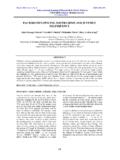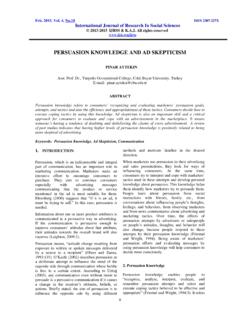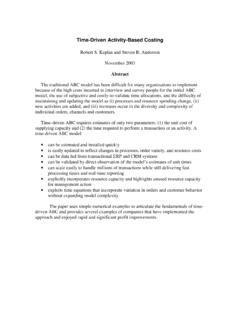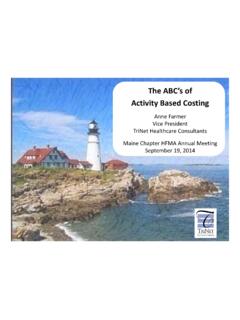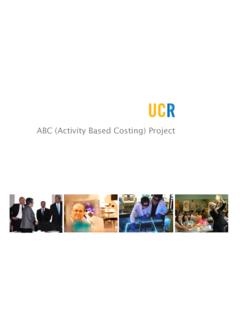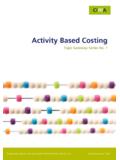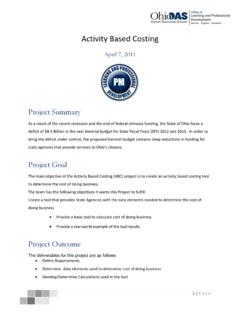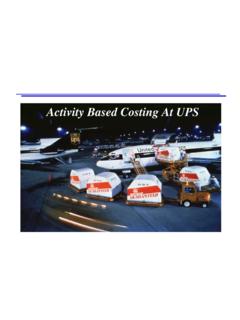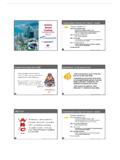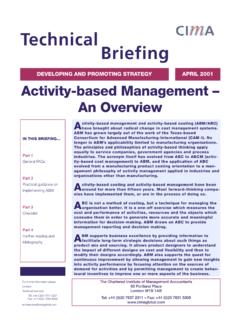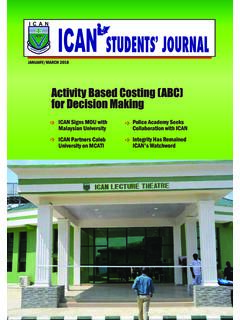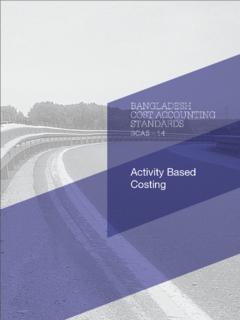Transcription of A COMPARISON OF ABSORPTION COSTING AND ACTIVITY …
1 July. 2015. Vol. 5, ISSN 2307-227X International Journal of Research In Social Sciences 2013-2015 IJRSS & All rights reserved 19 A COMPARISON OF ABSORPTION COSTING AND ACTIVITY based COSTING SYSTEMS THROUGH AN OPTIMIZATION PROBLEM ARIKAN TARIK SAYGILI1, CEVDET ALPTEK N KAYALI2 Assoc. Prof., Department of Management, Faculty of Economics and Administrative Sciences, Economy University, zmir, TURKEY1 Assoc. Prof., Department of Management, Faculty of Economics and Administrative Sciences, Manisa Celal Bayar University, Manisa, TURKEY2 E-mail: E-mail: ABSTRACT Accounting Information system (AIS) relied on for production of meaningful, reliable and timely data that will be used for various managerial decisions is an extremely important component of Management Information system (MIS).
2 Actually, some of the most crucial data used by managers either processed through or provided by AIS. In order to have an AIS that will produce reliable data, its components and tools & techniques to be used within this system need to be chosen and system need to be designed carefully. In this study, it is aimed to show the importance of COSTING systems that are subsystems of AIS for providing reliable information. A COMPARISON of traditional COSTING systems and ACTIVITY based COSTING systems through an optimization problem is presented and analyzed in the study to show how different outcomes can be produced even if the same data is processed. Also, the data processed by both COSTING systems can be interpreted differently and different managerial decisions such as pricing and resource/asset utilization can be made. Key words: Traditional COSTING Systems, ACTIVITY based COSTING system , Cost Driver 1.
3 INTRODUCTION Manufacturing process has been transformed into a more technology-intense rather than labor-intense structure due to recent and continuing developments in production technologies. Modern business conditions of companies can be characterized by more diverse general expenses that significantly participate in total cost of a company which has changed the cost profile/components of companies producing both goods and services. Technological innovations and automated manufacturing systems as well as CAD and CAM have deceased the unit manufacturing costs for many products and caused fixed costs to be an important component of total manufacturing costs (Barnes 1992). Also, as stated by Cardinaels, Roodhooft and Warlop (2004) when total life cycle of a product considered, it is obvious that marketing, selling and distribution costs have become quite significant for any product and therefore managerial decisions (Saygili, 2007).
4 Accounting Information Systems (AIS) have been a significant component of Management Information Systems (MIS) since, management prepares both tactical and strategic plans as well as budgets and feasibility reports based on data processed and provided by AIS (Laing, 1994; Saygili, 2007). Data provided by AIS becomes extremely important when considering today s intense competition environment requiring companies to trace and calculate costs related to any product in order to come up with the accurate unit costs, right prices for each specific product along with conducting accurate and reliable investment analysis and producing solid reports. This requires a reliable COSTING system that enables companies to trace and assign costs to any given cost object from the very beginning until the very end, that is, from production till sale of a specific product.
5 It has been thought that simple ( ABSORPTION ) COSTING methods have become rather insufficient in producing accurate data for pricing and other strategic managerial decisions. Moreover ABC providing detailed analysis that will help to eliminate or the least minimize activities that do not contribute to the useful value of while emphasizing on activities that will contribute to perceived and useful value of a product. In this sense ABC, when used appropriately, contributes to July. 2015. Vol. 5, ISSN 2307-227X International Journal of Research In Social Sciences 2013-2015 IJRSS & All rights reserved 20 resource utilization without compromising quality and performance characteristics of the product (Maher, 1997).
6 Especially in companies with significant indirect costs and wide range of product mixes, ACTIVITY based COSTING rather than a simple COSTING method is suggested (Oker, 2003; Titiz and Altunay, 2012). As stated by Karcioglu (2000), Hacirustemoglu and Sakrak (2002) and Unutkan (2010), ABC is a very useful managerial tool (Yildiz and Karaca 2011): To eliminate problems caused by inefficient allocation and/or misallocation of operational and production costs; To provide a more rational ground for better managerial and accounting and cost control procedures by determining cost causing factors and activities in a more detailed manner To measure production processes in terms of efficiency, effectiveness and quality through consideration of non-financial criteria as well. In order to understand the significant difference in results produced by both COSTING systems, features of both systems will be explored briefly in the next section.
7 2. ABSORPTION COSTING METHOD Simple COSTING method is widely used by majority of the companies in the world in order to calculate costs of Work-In Process (WIP) Inventory and Finished Goods Inventory figures in Balance Sheet along with Cost of Goods Sold (COGS) figure in Income Statement. However, it is argued whether simple COSTING system can produce accurate and reliable data for managerial decisions (Karatas et al., 2014; Charaf and Rahmouni, 2014; Kalicanin and Knezevic, 2013). Actually, as stated by Kaplan and many other researchers and believed by a majority of new generation managers that simple COSTING method is producing misleading data related to COSTING , pricing as well as other managerial decisions due to two important reasons: The first problem with simple COSTING methods is about allocation of Manufacturing Overhead (MO) expenses composed of various variable and fixed manufacturing costs apart from Direct Material and Direct labor costs.
8 Even, some components of MO have mixed cost structure possessing features of both variable and fixed costs. However, the allocation of all these different cost categories composing total MO is done by a single cost driver such as direct labor/direct machine hour considering solely production volume. However, this is believed to cause false information related to both unit costs and total product group costs especially in companies with diverse sales mix. The second issue that is problematic with simple COSTING systems is the way marketing selling and distribution costs are handled. In simple COSTING system , these costs are treated as period costs and therefore expensed at the end of each fiscal year. They are not included in COSTING calculations and/or pricing decisions. However, marketing, selling and distribution operations of companies are spread over extremely large geographical areas and their costs should not be ignored for any managerial decision making process in order to be competitive.
9 However, when marketing selling and distribution expenses are taken into consideration, proper methods need to be employed. Some companies try to allocate marketing selling and distribution costs based on sales volume solely, some even do not consider seasonal fluctuations. These kinds of application are subject to a great mistake though. Usually new products need more advertising and promotional costs even though they are sold at smaller quantities and generate smaller sales revenues compared to existing products . This causes newer products to absorb lesser from total marketing, selling and distribution costs even though simple logic suggests the opposite. 3. ACTIVITY based COSTING (ABC) The fundamental difference between traditional simple COSTING system and ACTIVITY based COSTING system (ABC) is evident at the process of allocating MO costs to each cost object.
10 As stated before, traditional simple COSTING system uses a single allocation base and cost driver in order to allocate indirect MO costs to cost objects. However, ABS system allocates indirect costs by using multi allocation bases and cost drivers, that is, a suitable cost driver for allocation of a certain cost. The whole process can simply be summarized as follows: 1. Determine the key activities 2. Determine a cost driver for each key ACTIVITY 3. Calculate the cost of each key ACTIVITY group 4. Calculate cost driver/allocation rate for each ACTIVITY by dividing ACTIVITY cost into allocation base 5. Allocate costs to each cost object via allocation rates. Different products in the sales mix of a company might be subject to same activities at different July. 2015.
